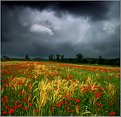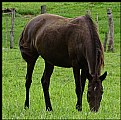|
|
 Roger Williams
Roger Williams
 {K:86139} 4/24/2004
{K:86139} 4/24/2004
|
John, you put your finger on something that was bothering me. Some sort of fuzziness inside the flowers. It's definitely NOT THERE in my original image as read from the compact flash card. I've half a mind to upload it and ask people what they think might have gone wrong. Probably something stupid I did (I'm so busy these days that it's often late at night before I can get around to preparing photos for upload, and by then I'm pretty tired.)
|
|
|
|
John Bohner
 {K:8368} 4/24/2004
{K:8368} 4/24/2004
|
Yep - nice comp but somehow the flower inner parts to outer parts seems confusing to me. Perhaps a polarizer?
jb
|
|
|
|
 Roger Williams
Roger Williams
 {K:86139} 4/23/2004
{K:86139} 4/23/2004
|
Actually, Craig, I'm thinking of getting back my Olympus OM4 from my less-than enthusiastic son, and using the macro capabilities of my 28-200 zoom. It's the macro envy I can't handle. Nothing else would have persuaded me to pick up that Digital camera. Flower closeups are SO beautiful. I want them to be a part of my photographic life...
|
|
|
|
|
Craig Hanson
{K:7836} 4/22/2004
|
Roger, a 1.5 megapixel digital camera is a true dinosaur! You shouldn't even consider comparing it to the ones which are being produced now. If however, you insist on continuing to use film along with your eight track player for the sake of nostalgia or whatever. I don't really mind. ;-)
|
|
|
|
 Roger Williams
Roger Williams
 {K:86139} 4/22/2004
{K:86139} 4/22/2004
|
This is a 1.5 megapixel camera, Craig, so the original quality is not very good, not nearly as good as the quality from the low-grade commercial scans of my negatives. There are even too few pixels for USM to work effectively... this is as good as it gets. One digital camera was enough for me; no intention of buying another!
|
|
|
|
 Roger Williams
Roger Williams
 {K:86139} 4/22/2004
{K:86139} 4/22/2004
|
No, Anontella, this camera was a very early generation, dating from about five years ago, and manual adjustments are buried inside obscure menus, so effectively it operates as a purely automatic P&S! I just have to take what it gives.
|
|
|
|
|
Craig Hanson
{K:7836} 4/22/2004
|
Beautiful flowers, composition and colors Roger, but the clarity is not so great. (Problem with scanning?) Maybe it's time for you to break down and buy a good digital SLR. ;-)
|
|
|
|
|
Antonella Nistri
{K:21867} 4/22/2004
|
The leaves are rendered beautifully,but some petals appear blurred. As we all know the color red is indeed difficult. I don't know whether this camera has an aperture setting,but in that case you might have close it more.
Kisses, Antonella
|
|
|
|
 Roger Williams
Roger Williams
 {K:86139} 4/22/2004
{K:86139} 4/22/2004
|
I guess I thought any "trio" can be a triptych. I see there's more to it than that. I quite like the idea of a real screen, with the three pictures all inside the frame, as you did here (thanks for all the effort involved!!). Anyway, I've just decided to go out on another shoot on Saturday, given good weather. I'll see what I come back with...
|
|
|
|
|
David Cohen
{K:1759} 4/21/2004
|
It seems like everyone has spring in their brains.
|
|
|
|
|
Enjoy
{K:16125} 4/21/2004
|
Very beautiful and great natural color...well done..these are outstanding... no fragrance right...?
|
|
|
|
|
Keith Naylor
{K:13064} 4/21/2004
|
Roger, Matej has apoint here, there needs to be something else to make a triptych really work. Have another look at Hugo's portfolio, you will find that there are numerous unifying elements to each triptych. You have to search for this in your submissions.
K
|
|
|
|
 Matej Maceas
Matej Maceas
 {K:24381} 4/21/2004
{K:24381} 4/21/2004
|
The problem I have with this triptych is that I can't find a unifying element (except that they're all flowers). The fact that the flowers are all of different species probably does not matter, but the differences in presentation do. We have different angles of view here, different levels of subject isolation from the surroundings, even different aspect ratios.
Have you considered presenting all three photos as a single image, possibly with some framing added? Placing them together might strenghten the ties as compared to viewing the three images in three different browser windows.
On the level of individual photos, I would welcome more "intimacy". A closer view, with all unimportant elements eliminated by focus or cropping (whether in-camera or postprocessing). A specific aspect of the flowers to concentrate on, that will serve as the main subject in the single photo and as the varying element in the whole. And some common element that will bind them all together. Or something like that :-)
I have tried this little experiment... In this case, the flowers in the side images ideally would have had the same density as those in the centre image. The colours should be the varying aspect; the thick growth that shows the flowers as a mass, thus de-emphasizing individual flowers in favour of colour and texture should be the common element; the yellow colour that frames the individual images is also a common element (it can be found in all three flowers).
What do you think?
|

example: colour |
|
|
|
|
Chris Spracklen
{K:32552} 4/21/2004
|
I find deep reds are very difficult to photograph, so you've done well to get the detail that you have.
Kind regards, Chris
|
|
|
|
 Roger Williams
Roger Williams
 {K:86139} 4/21/2004
{K:86139} 4/21/2004
|
Well, Matsukawa San, I can't take closeups with my favourite rangefinders, so I have to use my old digital. But that means I won't often feel like it... So I guess the answer is "interested, yes, but not going to do it very often."
|
|
|
|
 Hugo de Wolf
{K:185110} 4/21/2004
Hugo de Wolf
{K:185110} 4/21/2004
|
Hi Roger, I think this is my favourite one in this triptych. Very good combination of colours, and a beautifully "boxed in" composition. Good job!
Cheers,
Hugo
|
|
|
|
|
Koichi Matsukawa
{K:245} 4/21/2004
|
Williams San,
I think, the name of this flower is rhododendron.
Usually, when we take this kind of (red) flower, the green leaves turns blue, but this one is very nice color and contrast.
Are you going to be interested in taking flower photographs ?
Regards,
Koichi
|
|
















